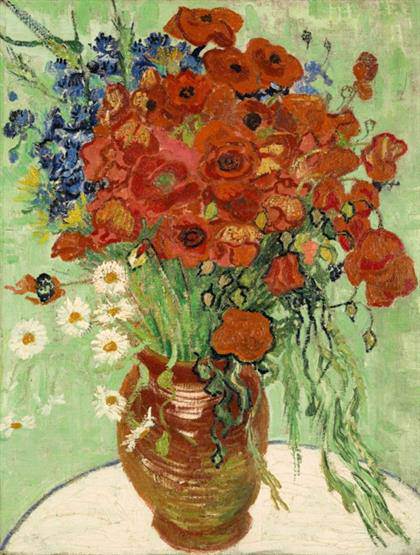
Vincent van Gogh
“Still Life, Vase with Daisies and Poppies”, 1890
Sotheby’s to auction a great still life by Van Gogh Sotheby’s will offer Vincent van Gogh’s ‘Still Life, Vase with Daisies and Poppies’ in its Evening Sale of Impressionist & Modern Art in New York on 4 November 2014. The work carries an estimate of $30/50 million.]]>
October 1, 2014, source: Sotheby’s
Painted at the home of Dr. Paul Gachet just weeks before the end of Van Gogh’s life, the artist uses the richly colored bouquet of wildflowers to convey his psychological state at the time – a hallmark of the Expressionist icon. The resulting composition teems with the intense energy, emotion and sensitivity of this creative genius at the height of his short but renowned career. Still Life is one of the few works that Van Gogh sold during his lifetime, and is one of only a handful of great works by the artist to appear at auction in recent decades. The painting comes to auction this November with a pre-sale estimate of $30/50 million.
“Still Life” was painted at Dr. Gachet’s house and presumably came immediately into his possession upon completion. The viewer can imagine Van Goghwalking through the fields on his way to Gachet’s, gathering up armfuls of poppies, daisies, cornflowers and sheaves of wheat to squeeze into one of the doctor’s modest vases. In comparison with the more reserved and academic still-lifes that he had completed in Paris in the mid-1880s, the present work evinces a dramatic shift in Van Gogh’s painterly style, characterized by a frenetic energy. The artist was flooded with anxiety in Auvers, and this agitation spilled over onto even his most optimistic canvases. It is in these same fields that Van Gogh would attempt to take his own life, only weeks after painting this work.
Still Life is one of the very few paintings sold during Van Gogh’s lifetime. It was acquired by Gaston Alexandre Camentron, a noted collector of Impressionist pictures, who eventually sold it to Paul Cassirer Gallery in 1911. “Still Life” remained with a series of private collectors in Germany until the mid-1920s, when it made its way to London and eventually to New York. one of the earliest works by the artist to enter the United States . where it was sold by the Knoedler Gallery in 1928 to A. Conger Goodyear. Known as one of the principle founders of the Museum of Modern Art, Goodyear kept this work in his family’s private collection. It was eventually gifted in part by the Goodyears to the Albright-Knox Art Gallery in Buffalo, where it was on display for over 30 years before it was sold at the request of the family.
Related content
Van Gogh’s ‘Moulin de la Galette’ at TEFAF 2014
Follow us on:


